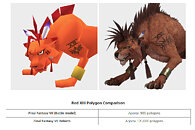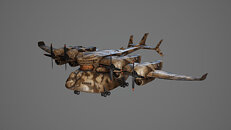T0@st
News Editor
- Joined
- Mar 7, 2023
- Messages
- 2,077 (3.15/day)
- Location
- South East, UK
It'd be fair to say Final Fantasy VII Rebirth's next-gen makeover of characters, monsters, and more from the 1997 original has been a spectacular glow-up. The modern console era has returned an iconic cast and world to us with a level of realism in gameplay that even pre-rendered cutscenes over 25 years ago couldn't match. We asked Square Enix if they could crunch some numbers and share some insight into the changes nearly three decades of technological advancement have wrought. Here, main character modeler and lead character artist Dai Suzuki walks us through a selection of characters, creatures, weapons, and more.
Dai Suzuki: When people think of Cloud, most think of his gigantic sword and his unique hairstyle. Because it is so iconic, we needed to put special effort into creating Cloud's hair for Final Fantasy VII Remake, to properly express his personality. The hair was an extremely high-priority element and in fact accounted for half of the total polygon count for the whole model. In Final Fantasy VII Rebirth, the hardware has been changed to PS5, allowing for a higher polygon count to be used than in Final Fantasy VII Remake.


Creating fur - Red XIII and Cait Sith
Dai Suzuki: Red XIII and Cait Sith's entire body is also rendered by the placement of many hair cards. Since their fur is one of their unique characteristics, it was necessary to not only just let their hair cards grow, but also to pay attention to the flow of the fur.


Their blocky appearance is adorable in the original too, but don't you just want to pet the new Cait Sith?
Character facial animations
Dai Suzuki: Polygons are essential not only in depicting a character's physical appearance, but also in expressing their inner personality. When expressing emotions through facial animation, facial distortion is greatly influenced by the total number of polygons.


The characters in the original version had relatively expressionless faces, but in Final Fantasy VII Remake and Final Fantasy VII Rebirth, their facial expressions allow us to convey the emotions of the characters much more powerfully.


Weapons - Buster Sword
Dai Suzuki: Weapons also have more polygons due to the increased detailing. The Buster Sword has a simple design, but most of the polygons were used around the materia slots and the leather wrap around the handle.

The materia that attaches to the weapon also has mesh on the weapon side, and out of the 8,000 polygons, approximately 1,000 polygons are used for the two materia slots.
Monsters - Midgardsormr
Dai Suzuki: Next, let's take a look at the modeling of the monsters. Midgardsormr's numerous spikes are modeled all the way down to the tip of its tail. These spikes, which were absent in the original version, make its silhouette even more menacing.

These details play an important role in conveying to the player the feeling of incurring lots of damage from the spikes when the creature lashes its large tail.
A matter of scale - from card keys to battleships - Largest and Smallest Polygon Counts
Dai Suzuki: Now, which of Final Fantasy VII Rebirth's objects uses the least number of polygons, and which uses the most? I don't have all the data myself, but the numbers here should not be too far off.

The smallest was a box used as a dummy model. This is data that isn't visible during the gameplay. Excluding this, I think the smallest would be a tiny note or a card key.
The largest is the battleship Relnikha, which Scarlett rides. This is used in the cutscenes, but it has such a large polygon count since we had to treat the interior not as a background but as an all-inclusive character.
In this article, we focused on polygon count differences between the original version and Rebirth. With the polygon counts, you can compare them through the numbers, so it's relatively straightforward. In game development, we often create a high-poly model with more than 10 million polygons for baking a Normal Map, but I wonder if we'll eventually have hardware that can effortlessly run such models in a game? While I'm not sure whether that would be a good idea, I do have high hopes for the future evolution of hardware.
Note: "Card" refers to polygons with hair-like design.
View at TechPowerUp Main Site | Source
Dai Suzuki: When people think of Cloud, most think of his gigantic sword and his unique hairstyle. Because it is so iconic, we needed to put special effort into creating Cloud's hair for Final Fantasy VII Remake, to properly express his personality. The hair was an extremely high-priority element and in fact accounted for half of the total polygon count for the whole model. In Final Fantasy VII Rebirth, the hardware has been changed to PS5, allowing for a higher polygon count to be used than in Final Fantasy VII Remake.


Creating fur - Red XIII and Cait Sith
Dai Suzuki: Red XIII and Cait Sith's entire body is also rendered by the placement of many hair cards. Since their fur is one of their unique characteristics, it was necessary to not only just let their hair cards grow, but also to pay attention to the flow of the fur.


Their blocky appearance is adorable in the original too, but don't you just want to pet the new Cait Sith?
Character facial animations
Dai Suzuki: Polygons are essential not only in depicting a character's physical appearance, but also in expressing their inner personality. When expressing emotions through facial animation, facial distortion is greatly influenced by the total number of polygons.


The characters in the original version had relatively expressionless faces, but in Final Fantasy VII Remake and Final Fantasy VII Rebirth, their facial expressions allow us to convey the emotions of the characters much more powerfully.


Weapons - Buster Sword
Dai Suzuki: Weapons also have more polygons due to the increased detailing. The Buster Sword has a simple design, but most of the polygons were used around the materia slots and the leather wrap around the handle.

The materia that attaches to the weapon also has mesh on the weapon side, and out of the 8,000 polygons, approximately 1,000 polygons are used for the two materia slots.
Monsters - Midgardsormr
Dai Suzuki: Next, let's take a look at the modeling of the monsters. Midgardsormr's numerous spikes are modeled all the way down to the tip of its tail. These spikes, which were absent in the original version, make its silhouette even more menacing.

These details play an important role in conveying to the player the feeling of incurring lots of damage from the spikes when the creature lashes its large tail.
A matter of scale - from card keys to battleships - Largest and Smallest Polygon Counts
Dai Suzuki: Now, which of Final Fantasy VII Rebirth's objects uses the least number of polygons, and which uses the most? I don't have all the data myself, but the numbers here should not be too far off.
- Smallest count: 12 polygons
- Largest count: Approx. 2,300,000 polygons

The smallest was a box used as a dummy model. This is data that isn't visible during the gameplay. Excluding this, I think the smallest would be a tiny note or a card key.
The largest is the battleship Relnikha, which Scarlett rides. This is used in the cutscenes, but it has such a large polygon count since we had to treat the interior not as a background but as an all-inclusive character.
In this article, we focused on polygon count differences between the original version and Rebirth. With the polygon counts, you can compare them through the numbers, so it's relatively straightforward. In game development, we often create a high-poly model with more than 10 million polygons for baking a Normal Map, but I wonder if we'll eventually have hardware that can effortlessly run such models in a game? While I'm not sure whether that would be a good idea, I do have high hopes for the future evolution of hardware.
- Dai Suzuki, Lead Character Artist, Square Enix
Note: "Card" refers to polygons with hair-like design.
View at TechPowerUp Main Site | Source




